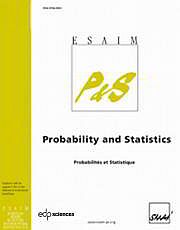Article contents
On the large deviations of a class of modulated additiveprocesses
Published online by Cambridge University Press: 05 January 2012
Abstract
We prove that the large deviation principle holds for a class ofprocesses inspired by semi-Markov additive processes. For theprocesses we consider, the sojourn times in the phase process neednot be independent and identically distributed. Moreover thestate selection process need not be independent of the sojourntimes. We assume that the phase process takes values in a finite set andthat the order in which elements in the set, called states, arevisited is selected stochastically. The sojourn times determinehow long the phase process spends in a state once it has beenselected. The main tool is a representation formula for the samplepaths of the empirical laws of the phase process. Then, based onassumed joint large deviation behavior of the state selection andsojourn processes, we prove that the empirical laws of the phaseprocess satisfy a sample path large deviation principle. From thislarge deviation principle, the large deviations behavior of aclass of modulated additive processes is deduced. As an illustration of the utility of the general results, we providean alternate proof of results for modulated Lévy processes. As apractical application of the results, we calculate the large deviationrate function for a processes that arises as the InternationalTelecommunications Union's standardized stochastic model of two-wayconversational speech.
Information
- Type
- Research Article
- Information
- ESAIM: Probability and Statistics , Volume 15: Supplement: In honor of Marc Yor , 2011 , pp. 83 - 109
- Copyright
- © EDP Sciences, SMAI, 2011
References
- 4
- Cited by

